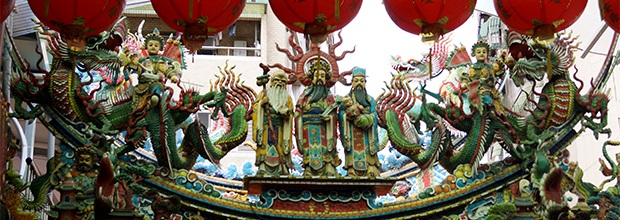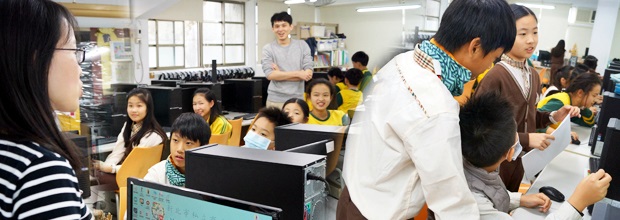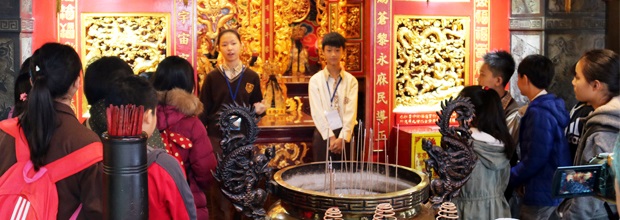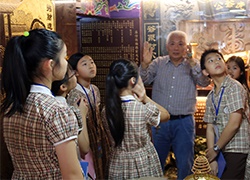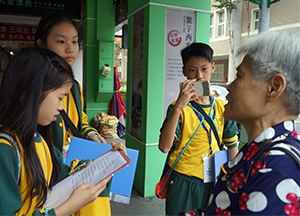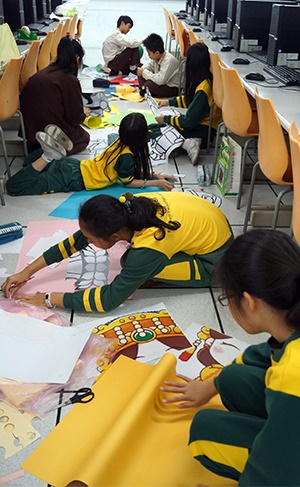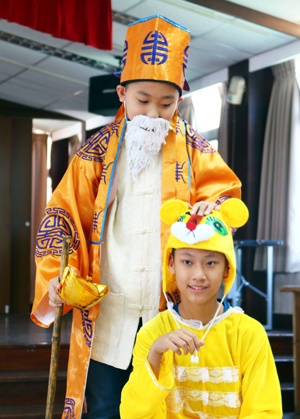 |
 |
 |
 |
 |
 |
 |
 |
 |
 |
 |
 |
|
Overview
The category we chose to participate in for the competition is "Local Attractions (Natural and Man-Made)"Description of "Our Community”Our school is located in Yonghe district, New Taipei City. Yonghe is located in the southeast corner of Taipei Basin, and its boundary with Taipei City is marked by Xindien River. There are currently Zhongzheng Bridge, Fuhe Bridge, and Yongfu Bridge that connect the two cities, and they facilitate the prosperous growth of Yonghe district. There are many business districts and markets for residents of Yonghe to enjoy. Besides the Korean Street and Lehua Night Market, Yonghe residents can head to Yang San Lang Art Museum or Fuhe Holiday Flower Market for more artistic venues and immerse themselves in the city’s relaxed atmosphere. Earth God temples are very common in Taiwan, it’s because Earth God is the deity who takes care of everything in the community. The most famous Earth God temple in Zhonghe and Yonghe districts is Nanshan Fude Temple, but not a lot of people know about Fude Temple on Dianzai Street, which is only a ten-minute walk from our school! Fude Temple on Dianzai Street, the subject of our research, is not only the historic, cultural, and religious center of Yonghe, but also the place that brings peace of mind to the locals. The temple cares about the people of Yonghe, and it is also the place where selfless love is offered to all unconditionally. Project Description
In 1671, the boom in transportation by the river made Yonghe district the center of commodity trade. Ships used to dock by what is presently Xiulang Road for business and rest, and that made the region more prosperous with more shops opening up. The region started to boom with more business activities, and the name Dianzai street (street with small shops) was given. It also became the first commercial area of Yonghe. The locals and the nearby businesses followed the tradition of building an Earth God temple (Fude temple) to bring protection and good fortune, and followers have been coming nonstop to the temple to pray ever since. Fude Temple on Dianzai Street has been around for more than three hundred years, and it is also one of the most famous Earth God temples in northern Taiwan. Undoubtedly, it is the Earth God temple with the longest history in Yonghe. Fude Temple on Dianzai Street continued Earth God’s spirit of protecting and caring for the locals with activities like ‘Donate Rice Instead of Gold’ to take care of disadvantaged locals. The temple takes donations from followers and channels them to people in need, spreading love to all corners of the society.
Yu-Tsai’s Cyberfair squad worked as a team on the topic. We learned more about the unique cultural values of the Fude Temple on Dianzai Street through interviews, field studies, researches, and participating in activities. We aimed to foster the spirit of caring for others and the notion of ‘it’s better to give than to receive.’ Our team members would first be seeds that study and experience the spirit of giving from the Fude Temple on Dianzai Street before introducing it to other schools, people in the community, and the world. Our Accessibility to the InternetSchool Internet Facilities:
We relied on school’s academic network to access the Internet. There are fifty computers in the computer room for regular classes and the Cyberfair project. There are one to four computers in each administrative office, and there is one computer in each classroom. Each computer has access to the Internet, and this allows us to discuss, research, and print materials for the project. Our Internet runs on the fiber optic network that is connected to the education network of New Taipei city. We also have wireless connection for teachers. Internet Connectivity at Home for the Team:ADSL, fiber optic, wireless network. How we handle information:We completed most of our research through the LAN at school or Google Classroom. If we need to take something home, we would use portable storage devices, Google Drive, or emails to store data from school’s LAN. Once the work is done, we would then bring the file back to school and upload it to school’s LAN. Problems We Had To OvercomeData collection
Deity is very abstract. When we were collecting data on the Internet, we were not able to verify the accuracy of data. We relied on multiple sources to cross-reference the source. In addition, staff from the temple and writings on the lunar calendar gave us a more supporting data on the topic. Interviews and surveys
When we first started asking people for an interview, we were not well-received because we interrupted them when they were in the middle of their prayer. As a result, we learned to wait until people finished worshipping before approaching them for an interview. We got a lot of interviews done and collected valuable first-hand data! Time allocation
There is always work for Cyberfair, and when it comes around exam time, we had to allocate our time wisely. After a few months of training, we were able to prioritize our work. We learned to be more efficient so we would have time to help our teammates out and do the things that we enjoy. Express ourselvesBefore joining Cyberfair, I was really nervous about expressing myself. I kept on telling myself to be brave and amplify my voice, and gradually, I got over it. Now, I’m able to give a guided tour of them temple in front of my schoolmates and help out at the temple confidently. I know as long as I practice, I’m able to do it! My performance may not be the best, but I will always finish my mission bravely. AfterthoughtsIn our research, we learned a lot about Taiwanese folk religion from Fude Temple on Dianzai Street. After the research, we will be able to appreciate temples from different perspectives in our future visits.
In order to complete various activities for the project, we learned to work closely with our teammates, interview and survey strangers, perform in front of schoolmates, give a guided tour of the temple to our classmates, and handle different jobs at the temple. We shared the results with our schoolmates, teachers, people in the community, and the whole world. Even though Cyberfair took up a lot of our time, we were happy because we got a lot out of it! The rare opportunities to expand our horizon and research on such a unique project are truly amazing. ‘You reap what you sow’ is a good way to describe our learning experience at Cyberfair. Text: The Wondrous Temple Expedition │ Photos: The Wondrous Temple Expedition |
 |
 |

